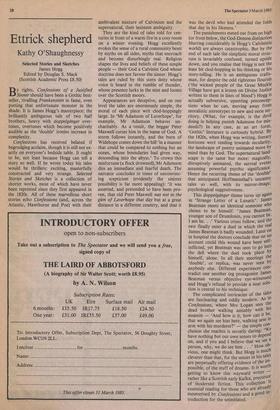atria shepherd
Kathy 0' Shaughnessy
Selected Stories and Sketches James Hogg Edited by Douglas S. Mack (Scottish Academic Press £8.50) y rights, Confessions of a Justified Sinner should have been a Gothic best- seller, rivalling Frankenstein in fame, even putting that unfortunate monster in the shade. It is James Hogg's masterpiece: the brilliantly ambiguous tale of two half brothers, heavy with doppelgeinger over- tones, overtones which become positively audible as the 'double' ironies increase in complexity.
Confessions has received belated if begrudging acclaim, though it is still not ex- actly on everyone's bedside table. It ought to be, not least because Hogg can tell a story so well. If he wrote today his tales would be thrillers: exciting, masterfully constructed and very strange. Selected Stories and Sketches is a collection of shorter works, most of which have never been reprinted since they first appeared in the 1820s. All of these marvellous short stories echo Confessions (and, across the Atlantic, Hawthorne and ,Poe) with their
ambivalent mixture of Calvinism and the supernatural, their insistent ambiguity.
They are the kind of tales told for cen- turies in front of a warm fire in a cosy room on a winter evening. Hogg excellently evokes the sense of a rural community beset by myths on all sides, myths that encroach and become disturbingly real. Religion shapes the lives and beliefs of these simple people — their God a Calvinist God whose doctrine does not favour the sinner. Hogg's tales are ruled by this stern deity whose voice is heard in the rumble of thunder, whose presence lurks in the mist and looms over the Scottish moors.
Appearances are deceptive, and on one level the tales are enormously simple, the moral of each piece writ clod-hoppingly large. In `Mr Adamson of Laverhope', for example, Mr Adamson behaves un- charitably. As a result, the beggar Peter Maxwell curses him in the name of God. A storm follows instantly, and the burn of Widehope comes down the hill 'in a manner that could be compared to nothing but an ocean, whose boundaries had given way, descending into the abyss.' To crown this misfortune (a flock drowned), Mr Adamson dies an immediate and fearful death. The narrator concludes in tones of unconvinc- ing scepticism (evidently the sinister possibility is far more appealing): 'It was asserted, and pretended to have been pro- ven, that old Peter Maxwell was not in the glen of Laverhope that day but at a great distance in a different country, and that it
was the devil who had attended the folds that day in his likeness.'
The punishments meted out from on high (or from below, the God-Demon distinction blurring considerably in Hogg's Calvinistic world) are always catastrophic. But by the end of each tale the simplistic moral struc- ture is invariably confused, turned upside down, and you realise that Hogg is not the least bit clod-hopping in his thinking or his story-telling. He is an ambiguous crafts- man, for despite the odd righteous flourish (`the wicked people of the Great Muckle Village have got a lesson on Divine Justice written to them in lines of blood') Hogg is actually subversive, upsetting preconcep- tions when he can, moving away from moralistic stereotypes to new and eerie ter- ritory. (What, for example, is the devil doing in helping punish Adamson for mis- deeds?) In any case, as an art form, 'Gothic' literature is curiously hybrid. BY the 1820s, when Hogg was writing, literarY horizons were tending towards secularity, the landscape of poetry animated more by mind than by God. The supernatural land- scape is the same but more: magically, disruptively animated, the surreal events assuming powerful psychic significance: Hence the recurring theme of the 'double' that anticipated Hoffrnansthal's uncanny tales so well, with its mirror-image, psychological suggestiveness.
This doppelgeinger theme turns up again in 'Strange Letter of a Lunatic'. James Beatman meets an identical someone who claims to be himself. 'James Beatman, younger son of Drumlonin, you cannot be. I am he. . .' Various crises follow, and the two finally enter a duel in which the real James Beatman is badly wounded. Later on in hospital the doctors conclude that on no account could this wound have been self- inflicted, yet Beatman was seen to go
into
the dell where the duel took place bY himself, alone. In all their meetings the 'double', or replica, was never seen bY anybody else. Different experiences con- tradict one another (eg protagonist James Beatman versus objective eye-witnesses) and Hogg's refusal to provide a neat solu- tion is central to his technique. The complicated intricacies of the tales are fascinating and oddly modern. As io Confessions, where Mrs Logan sees the dead brother walking amiably with his assassin — 'And how is it, how can it be, that we again see him here, walking arm in arm with his murderer?' — the simple cOn- clusion she reaches is secretly daring: 'We have nothing but our own senses to depend on, and if yOu and I believe that we see a person, why, we do see him . . .' How ob- vious, one might think. But Hogg is much cleverer than that, for the senses in his tales are perpetually offering evidence of the lin- possible, of the stuff of dreams. It is worth getting to know this wayward writer — rather like a Scottish early Kafka, precurs of modernist fiction. This collection Is essential reading for those who are alreadY mesmerised by Confessions and a good in-
troduction for the uninitiated. or














































 Previous page
Previous page